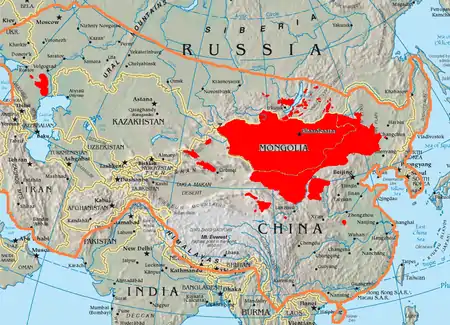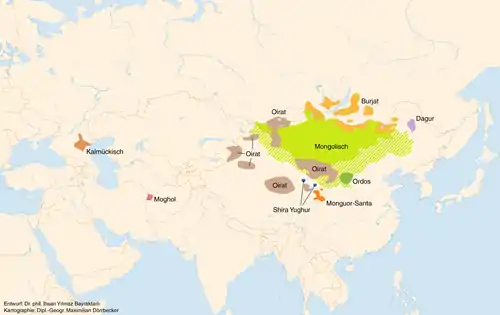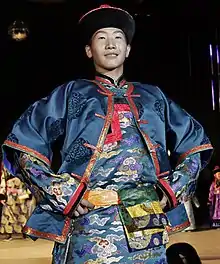Mongolic peoples
The Mongolic peoples are a collection of East Asian originated ethnic groups in East, North, South Asia and Eastern Europe, who speak Mongolic languages. Their ancestors are referred to as Proto-Mongols. The largest contemporary Mongolic ethnic group is the Mongols.[1][2] Mongolic-speaking people, although distributed in a wide geographical area, show a high genetic affinity to each other,[3] and display continuity with ancient Northeast Asians.[4]

| Wikimedia Commons has media related to Mongolic peoples. |
List of ethnic groups
Contemporary ethnic groups
In addition, Mongolized Soyots live in Buryatia. Their population is 3600 people. A number of orientalists (Nanzatov, Baldaev and others) traditionally consider modern Soyots as a sub-ethnos within the Buryat people.[5][6]
Ethnic groups of Mongolian origin
A large Mongolian component took part in the ethnic formation of the Hazaras. Even in the 16th century, according to Babur, the Mongolian language was widespread among the Hazaras, and a small part of them, apparently, spoke a language close to Mongolian as early as the 19th century.[7] The high frequency of haplogroup C2-M217 is consistent with the purported Mongolian origin of many of the Hazaras.[8] Modern Hazaras speak the Hazaragi, one of the dialects of the Dari/Persian language. According to the Great Russian Encyclopedia until the 19th century Hazaras spoke Mongolian.[9]
The Mughals, descendants of the Barlas and other Mongol tribes, currently speak Urdu.[10]
General characteristics
Languages

Languages of the Mongolic peoples belong to the Mongolic language family.[11] The Mongolic languages are a language family spoken in Eastern Europe (Kalmykia), Central Asia, North Asia and East Asia. The best-known member of this language family, Mongolian, is the primary language of most of the residents of Mongolia and the Mongol residents of Inner Mongolia and Buryatia, with an estimated 5.7+ million speakers.[12]
The Mongolic ethnicities possibly related to the Turkic and Tungusic peoples whom languages together would include into the hypothetical Altaic language family.[13]
Religions
The Mongolic peoples are predominantly followers of Tibetan Buddhism. In 1576 the Gelug Tibetan school which was founded by the half-Mongol Je Tsongkhapa became the state religion of the Mongolia. Some groups such as Dongxiangs and Bonan people adopted Sunni Islam, as did Moghols in Afghanistan and Mughals in India. Among a part of the population, the ethnic religion, namely Tengrism (Mongolian shamanism) is preserved. A small number of Christians emerged under the influence of the Russian Church and Western missionaries.
Mongolian shamanism, more broadly called the Mongolian folk religion, or occasionally Tengerism, refers to the animistic and shamanic ethnic religion that has been practiced in Mongolia and its surrounding areas (including Buryatia and Inner Mongolia) at least since the age of recorded history. In the earliest known stages it was intricately tied to all other aspects of social life and to the tribal organization of Mongolian society. Along the way, it has become influenced by and mingled with Buddhism.[14]
Culture
The Culture of Mongolia has been heavily influenced by the Mongol nomadic way of life and shows similarities to other East Asian and Central Asian cultures. The various Mongolic ethnic groups share a highly similar culture and traditions, but have specific differences in clothing styles and cuisine. Although Mongolian traditional clothing (deel) has changed little since the days of the empire, there have been some changes in styles which distinguish modern Mongolian dress from historic costume. Each tribe or clan has its own deel design distinguished by cut, color, and trimming. Mongolian cuisine is primarily based on meat and spices, with some regional variations. The most important public festivals are the Naadam. A Naadam involves horse racing, wrestling, and archery competitions. For families, the most important festival is Tsagaan Sar (Lunar New Year), which is roughly equivalent to the Chinese New Year and usually falls into January or February. Mongolia has a very old musical tradition. Key traditional elements are throat-singing, the Morin Khuur (horse head fiddle) and other string instruments, and several types of songs. Mongolian melodies are typically characterized by pentatonic harmonies and long end notes.
Genetics
Mongols and other Mongolic-speaking groups, show high genetic affinity to each other, as well as to other East Asian populations. The analysis of 175 Mongolic samples, representing 6 ethnic groups, incorporating results of the 1000 Genomes Project panel, revealed genetic homogenity between different Mongolic groups, and strong affinity between North, East, and Southeast Asian populations. Furthermore, derived allele sharing between Finns and Mongolians/Siberians, suggest substantial gene flow from East Asian-related groups westwards into a population ancestral to modern Finns.[15]
A 2014 paper investigated Mongolian geneflow into populations of Europe and South Asia, which can be mostly traced back to the time of the Mongol empire. The study analyzed the genome of a Mongolian individual from Inner Mongolia, and compared the sample with worldwide populations. The Mongolian individual showed expected high affinity to other East Asian and Native American populations. The highest affinity of the Mongolian sample was to Oroqen in Russia. A relative large amount of ancestral alleles shared with Native Americans (Maya) most likely have resulted from the Mongolians’ ancestors contribution to the peopling of the Americas. Europeans had a low, but relative higher allele sharing with Mongolians and other East Asians, than Middle Easterners, suggesting greater impact of Mongolian geneflow towards Europeans during the Mongol Empire. Indians also show evidence of minor geneflow from Mongolians, associated with the Mughal dynasty, but like Middle Easterners at a lower percentage than Europeans. The authors concluded that Mongolian-specific ancestry is found in most populations which were under the control of the Mongol empire at low frequency, suggesting a lasting impact of Mongolians onto Eurasian populations, with the relative strongest impact of Mongolian-specific ancestry among Europeans.[16]
A 2021 paper analyzed 42 individuals from different Mongolic sub-populations and found that all Mongolic groups have dominant East-Eurasian (East Asian-related) ancestry, specifically a Northeast Asian hunter-gatherer component (ANA, represented by DevilsCave_N or Mongolia/Baikal_N_North), and a Yellow River millet farmers component (YR_LN). Low proportion of West-Eurasian-related ancestry, related to Western Steppe Herders (WSH), contributed to the gene pool of modern Mongolians ranging from 5.6% to 11.6%. The admixture event was estimated in the period ranging from Tang dynasty to Yuan dynasty.[17]
Another 2021 paper analyzed 611 Mongolian individuals from China, Mongolia, Russia, the Republic of Kazakhstan, and other countries in East Asia, Central Asia, Europe, and America. The geographically different Mongolian populations were found to be bound together by a common genetic heritage. Modern Mongolians also show high affinity to ancient and medieval Mongol samples, suggesting genetic continuity with ancient Mongol samples.[18] Mongolian samples from different geographical regions have slightely different ancestry make-up: Mongolians generally have mostly dominant East Asian-related ancestry, with a strong genetic affinity to the "Ancient Northeast Asians lineage" (ANA), such as the 7700-year-old DevilsGate people and 5000–6000-year-old Boisman sample, less to Ancient Yellow River famers. West-Eurasian-related admixture among Mongolian samples from Inner Mongolia and eastern Mongolia was found to be generally less than 5%, while Mongolian samples from Central Asia and the Altai mountains region showed slightly higher amounts, at approximately ~8%. The West-Eurasian-related ancestry was mostly contributed by female mitochondrial lineages, showing decreasing frequencies from west to east.[19]
A 2022 paper found that the low West-Eurasian-related ancestry among Mongolians, which exists on a West-to-East cline, decreasing to nearly ~0% among Hulunbuir Mongolians, was mostly female-mediated, and correspond with the presence of West-Eurasian associated mitochondrial haplogroups among western Mongolians, which arrived within the timeframe and geographic extension of the Mongol Empire, although evidence for a time period during the Bronze Age also exists. Overall, Mongolians cluster closely with other East Asian populations, and share the highest affinity with modern Northeast Asians.[20]
Notes
- Such subgroups of the Mongols as the Buryats and the Kalmyks are recognized in Russia as distinct ethnolinguistic groups (see 2010 Census and other).
References
Citations
- Zhukovskaia 2007, p. 354.
- Nimaev 2011.
- Bai, Haihua; Guo, Xiaosen; Narisu, Narisu; Lan, Tianming; Wu, Qizhu; Xing, Yanping; Zhang, Yong; Bond, Stephen R.; Pei, Zhili; Zhang, Yanru; Zhang, Dandan (December 2018). "Whole-genome sequencing of 175 Mongolians uncovers population-specific genetic architecture and gene flow throughout North and East Asia". Nature Genetics. 50 (12): 1696–1704. doi:10.1038/s41588-018-0250-5. ISSN 1546-1718. PMID 30397334. S2CID 53222895.
- Wang, Mengge; He, Guanglin; Gao, Shuang; Jia, Fuquan; Zou, Xing; Liu, Jing; Wang, Shouyu; Ye, Ziwei; Hou, Yiping; Wang, Zheng (2021-07-01). "Molecular genetic survey and forensic characterization of Chinese Mongolians via the 47 autosomal insertion/deletion marker". Genomics. 113 (4): 2199–2210. doi:10.1016/j.ygeno.2021.05.010. ISSN 0888-7543. PMID 34022340. S2CID 235126419.
- Нанзатов Б. З. (2003). "Племенной состав бурят в XIX веке" (in Russian) (Народы и культуры Сибири. Взаимодействие как фактор формирования и модернизации ed.): 15–27.
{{cite journal}}: Cite journal requires|journal=(help) - Балдаев С. П. (1970). Родословные легенды и предания бурят. Ч. 1. Улан-Удэ. p. 166.
- Массон В. М., Ромодин В. А. (1964). История Афганистана. Том I. С древнейших времен до начала XVI века. Москва: Наука. pp. 289–290. In Russian: "Еще в XVI в., по сообщению Бабура, среди хазарейцев был распространен монгольский язык, а небольшая часть их, по-видимому, и в XIX в. говорила на языке, близком к монгольскому."
- Жабагин М. К. (2017). Анализ связи полиморфизма Y-хромосомы и родоплеменной структуры в казахской популяции Москва. p. 71. In Russian: "...за счет высокой частоты гаплогруппы С2-М217, что согласуется с монгольским происхождением хазарейцев."
- "Хазарейцы • Большая российская энциклопедия - электронная версия". bigenc.ru. In Russian: "Упоминаются с 16 в. До 19 в. говорили на монг. языке."
- Сабитов Ж. М., Баймуханов Н. Б. (2015). "Y-STR гаплотипы узбеков, уйгуров, таджиков, пуштунов, хазарейцев, моголов из базы данных Family Tree DNA" (in Russian) (2) (The Russian Journal of Genetic Genealogy ed.): 22–23.
{{cite journal}}: Cite journal requires|journal=(help)CS1 maint: date and year (link) - Janhunen 2003.
- Svantesson, Jan-Olof; Tsendina, Anna; Karlsson, Anastasia; Franzén, Vivan (2005). The Phonology of Mongolian. New York: Oxford University Press.
- Starostin, George (2016-04-05). "Altaic Languages". Oxford Research Encyclopedia of Linguistics. Oxford University Press. doi:10.1093/acrefore/9780199384655.013.35. ISBN 978-0-19-938465-5.
- Shimamura, Ippei (2004). "Yellow Shamans (Mongolia)". In Walter, Mariko Namba; Neumann Fridman, Eva Jane (eds.). Shamanism: An Encyclopedia of World Beliefs, Practices, and Culture. Vol. 1. ABC-Clio. pp. 649–51. ISBN 9781576076453. Archived from the original on 2014-07-15.
- Bai, Haihua; Guo, Xiaosen; Narisu, Narisu; Lan, Tianming; Wu, Qizhu; Xing, Yanping; Zhang, Yong; Bond, Stephen R.; Pei, Zhili; Zhang, Yanru; Zhang, Dandan (December 2018). "Whole-genome sequencing of 175 Mongolians uncovers population-specific genetic architecture and gene flow throughout North and East Asia". Nature Genetics. 50 (12): 1696–1704. doi:10.1038/s41588-018-0250-5. ISSN 1546-1718. PMID 30397334. S2CID 53222895.
- Bai, Haihua; Guo, Xiaosen; Zhang, Dong; Narisu, Narisu; Bu, Junjie; Jirimutu, Jirimutu; Liang, Fan; Zhao, Xiang; Xing, Yanping; Wang, Dingzhu; Li, Tongda (2014-12-01). "The Genome of a Mongolian Individual Reveals the Genetic Imprints of Mongolians on Modern Human Populations". Genome Biology and Evolution. 6 (12): 3122–3136. doi:10.1093/gbe/evu242. ISSN 1759-6653. PMC 4540083. PMID 25377941.
- Yang, Xiaomin; Sarengaowa; He, Guanglin; Guo, Jianxin; Zhu, Kongyang; Ma, Hao; Zhao, Jing; Yang, Meiqing; Chen, Jing; Zhang, Xianpeng; Tao, Le (2021). "Genomic Insights Into the Genetic Structure and Natural Selection of Mongolians". Frontiers in Genetics. 12: 735786. doi:10.3389/fgene.2021.735786. ISSN 1664-8021. PMC 8693022. PMID 34956310.
The gene flow from Western Eurasian was preliminarily detected in Mongol population of TreeMix-based phylogenetic tree; the ancestral source was finally identified in qpAdm, ranging from 5.6 to 11.6% in those Mongolian subgroups; ALDER and GLOBETROTTER supported that the west-east admixture event was recently estimated in the period ranging from Tang Dynasty to Yuan Dynasty.
- Wang, Mengge; He, Guanglin; Gao, Shuang; Jia, Fuquan; Zou, Xing; Liu, Jing; Wang, Shouyu; Ye, Ziwei; Hou, Yiping; Wang, Zheng (2021-07-01). "Molecular genetic survey and forensic characterization of Chinese Mongolians via the 47 autosomal insertion/deletion marker". Genomics. 113 (4): 2199–2210. doi:10.1016/j.ygeno.2021.05.010. ISSN 0888-7543. PMID 34022340. S2CID 235126419.
- Wang, Mengge; He, Guanglin; Gao, Shuang; Jia, Fuquan; Zou, Xing; Liu, Jing; Wang, Shouyu; Ye, Ziwei; Hou, Yiping; Wang, Zheng (2021-07-01). "Molecular genetic survey and forensic characterization of Chinese Mongolians via the 47 autosomal insertion/deletion marker". Genomics. 113 (4): 2199–2210. doi:10.1016/j.ygeno.2021.05.010. ISSN 0888-7543. PMID 34022340. S2CID 235126419.
- Cardinali, Irene; Bodner, Martin; Capodiferro, Marco Rosario; Amory, Christina; Rambaldi Migliore, Nicola; Gomez, Edgar J.; Myagmar, Erdene; Dashzeveg, Tumen; Carano, Francesco; Woodward, Scott R.; Parson, Walther (2022). "Mitochondrial DNA Footprints from Western Eurasia in Modern Mongolia". Frontiers in Genetics. 12: 819337. doi:10.3389/fgene.2021.819337. ISSN 1664-8021. PMC 8773455. PMID 35069708.
Sources
- Janhunen, Juha, ed. (2003). The Mongolic languages. Routledge Language Family Series. London; New York: Routledge. ISBN 978-0-7007-1133-8.
- Nimaev, Daba (2011). Монгольские народы: Этническая история и современные этнокультурные процессы [The Mongolic Peoples: Ethnic History and Contemporary Ethnocultural Processes] (in Russian). Lambert Academic Publishing. ISBN 978-3843324403.
- Zhukovskaia, Natalia L. (2007) [1998]. "Монгольские народы" [Mongolic peoples]. In L.M. Mints (ed.). Народы мира: Энциклопедия [Peoples of the World: an Encyclopedia] (in Russian). Moscow: OLMA Media Group. pp. 354–356. ISBN 978-5-373-01057-3.

.svg.png.webp)